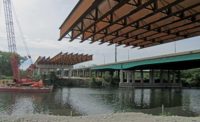“At the time, WisDOT did not understand these materials to be corrosive.”
The department now has developed a screening tool for bridges, especially in urban areas, and has found one or two components, but this one is “unique,” Becker says.
“It’s only in that area where that type of fill was, and the water level going up and down,” he says.
Seventeen other piers, ranging from numbers 6 to 50, were classified as “Tier 2,” showing lower levels of pile corrosion damage and sitting in “less severe” soil conditions. Those piers are located on both sides of the Fox River.
They “warrant further investigation and monitoring to determine if there is a potential for future reduction in the structural capacity of the foundations due to long-term corrosion,” the report said.
Monitoring probes and steel coupons, or pile sample sections, have been installed at seven of the Tier 2 piers and will be inspected quarterly for several years, then semiannually before going to an annual check, the report said. Monitoring will be part of the regular bridge inspection, Buchholz said.
The monitoring probes and steel coupons are also at Pier 22.
The remainder Tier 3 piers show “minimal corrosion” and have a “very low” potential for severe corrosion.
Pier 22 sank 2.5 ft in late September 2013, creating a sag in a 400-ft span and shutting down the 8,000-ft bridge that carries an average 40,000 vehicles daily.





Post a comment to this article
Report Abusive Comment